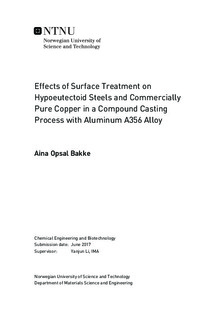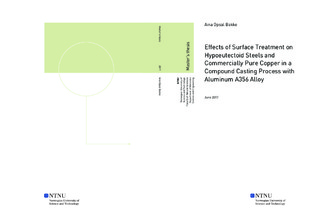| dc.description.abstract | Evidence of climate change has caused industries worldwide to start measures towards reducing greenhouse gas emission. The automotive industry is a large contributor to emission and has therefore demanded production of lighter, and thus less fuel-demanding, vehicles. A suggested method is by substituting steel components with aluminum alloys. However, a complete substitution is not possible as components require specific properties. As a result, the need for multi-material components arises. Compound casting is a process where strong multi-materials of complex shape can be manufactured. Bonding between aluminum and a second metal has proved difficult due to a thermodynamically stable oxide layer forming spontaneously on the aluminum surface.
In this thesis, the effects of various surface treatments on both copper and steel pipes were investigated through a low pressure die casting process. Characterizations of the aluminum-copper and aluminum-steel interfaces as result of the surface treatment were performed. Based on results from the aluminum-steel characterization, a shape casting experiment between aluminum A356 and steel inserts was conducted.
For the low pressure die cast aluminum-steel castings, bonding results improved when using galvanized steel pipes with flux coating. When using a thin zinc-layer, flux coating remained in the interface. No surface treatment caused poor bonding as oxides were entrapped. Ternary brittle Al4.5FeSi particles with various lengths were observed in the interface. Lengths appeared to increase with pouring temperature of the liquid melt. Heat-treated castings showed an increase in the reaction layer thickness, which included formation of a brittle Al$_{3}$Fe-layer. In the shape casting experiment, mainly mechanical bonding was achieved due to insufficient heating of the steel insert. Local metallurgical bonding was achieved at the tip of the cone-shaped steel inserts. Flux coating was deemed preferable as several pores were observed in the interface of the non-coated castings. Argon gas flushed through the mold improved bonding ability. For the low pressure die cast aluminum-copper castings, metallurgical bonding was achieved without surface treatment of the copper pipes. The interface showed formation of a eutectic Al2Cu+(Al) structure. In addition, silicon particles were observed both in the eutectic structure and adjacent to the copper pipe. Flux coating caused poor interfacial bonding due to the formation of magnesium compounds with high melting temperatures preventing further flux reaction. | |

